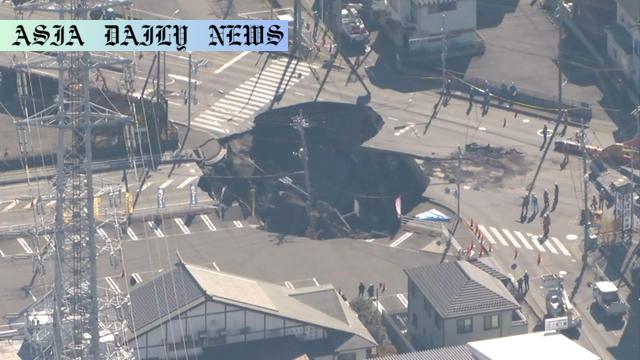Sinkhole: Authorities in Saitama Prefecture, Tokyo, strive to rescue a trapped driver following a major sinkhole collapse at Yashio City intersection.

A Complex Rescue Effort in Yashio City
The city of Yashio in Saitama Prefecture, near Tokyo, is grappling with an extraordinary crisis after a massive sinkhole trapped a truck driver. The 10-meter wide and 5-meter deep hole emerged abruptly at an intersection, resulting in dire consequences for the 74-year-old driver who remains trapped in the collapsed road. Local authorities have launched a challenging rescue mission while tackling a variety of interlinked emergencies caused by this incident.
Sewage Discharge and Environmental Precautions
To aid the rescue effort, sewage water accumulated around the sinkhole is being redirected. Authorities began pumping this contaminated water late Wednesday night and are transferring it to nearby rivers after thorough chlorine disinfection. While these rivers are not used as drinking water sources, environmental concerns persist. Officials are already considering discharging sewage into two additional rivers to maintain control over the situation.
The Root Cause: A Broken Sewage Pipe
Investigations revealed that a ruptured sewage pipe was the underlying cause of the collapse. This infrastructural failure led to water leakage, which in turn eroded the underlying soil and compromised the stability of the ground. Disturbingly, another sinkhole materialized nearby due to further erosion. The soil between the two holes has since collapsed, creating an enlarged danger zone. Authorities predict more sinkholes may form as unstable ground continues to shift.
Rescue Challenges and Innovative Solutions
Rescue teams face immense challenges as they attempt to reach the driver under precarious conditions. The risk of further collapses adds complexity to this mission. Crews have turned to advanced technology, including drones, to survey the inside of the sinkhole and deployed small machinery to safely remove mud and debris. However, these efforts are slow, as rescuers must work cautiously to avoid triggering additional cave-ins or endangering their own lives.
Long-term Implications and Public Guidance
The sinkhole crisis has exposed broader issues within the region’s sewage infrastructure. Officials have confirmed that repairing the ruptured pipe and addressing the aftermath of this disaster will take considerable time. In the interim, they are urging residents living near the upper reaches of the sewage system to minimize their water usage to prevent further complications. This precautionary measure underscores the extended recovery timeline and the lasting impact on the community.
The Human Cost and Uncertain Outcome
As the rescue effort continues, the condition of the trapped driver is still unknown, heightening concerns over his wellbeing. The incident serves as a sobering reminder of how vulnerable humans can be to sudden infrastructural failures. While authorities and rescue teams remain committed to saving the driver and stabilizing the situation, the uncertainty surrounding his fate adds a human element to this evolving story.
Conclusion: A City United in Crisis
The sinkhole crisis in Yashio City has brought to light the intertwined issues of aging infrastructure, environmental safety, and emergency response. While the immediate focus remains on rescuing the truck driver, the broader implications of this event will likely influence urban planning policies and disaster preparedness strategies in the region for years to come.
Commentary
A Stark Reminder of Infrastructure Vulnerabilities
The recent sinkhole collapse in Yashio City highlights the fragility of urban infrastructure in an era of aging systems and growing demands. The rupture of a seemingly ordinary sewage pipe has not only endangered lives but also brought an entire community to its knees. This incident prompts us to critically evaluate the state of our cities and the unseen systems that keep them functioning.
The Human Element of Resilience and Risk
What stands out in this story is the unwavering dedication of the rescue teams risking their safety to save a trapped driver. Their resourcefulness, from using drones to small machinery, demonstrates human resilience during crises. Yet, these efforts also underline the need for more robust disaster management frameworks to mitigate such risks and improve response timelines.
Environmental and Ethical Considerations
While pumping sewage water into local rivers might be a practical solution for this emergency, it raises important environmental and ethical considerations. Disinfecting water with chlorine mitigates immediate concerns, but long-term ecological impacts remain uncertain. These actions emphasize the necessity of balancing human rescue efforts with environmental sustainability.
Moving Forward: Lessons Learned
Yashio City’s crisis serves as a wake-up call for policymakers, engineers, and urban planners worldwide. Proactive inspections and timely repairs of critical infrastructure could prevent such disasters in the future. Moreover, government officials should focus on public education and early warnings for potential infrastructure failures, ensuring communities are better prepared to face such emergencies.


